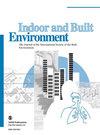温度阶跃变化环境下脑电图与唾液 IgE 关系的研究
IF 2.9
3区 工程技术
Q2 CONSTRUCTION & BUILDING TECHNOLOGY
引用次数: 0
摘要
通常作为人体免疫指标的唾液免疫球蛋白 E(IgE)水平会随着气温的变化而发生显著变化。脑电图(EEG)是评估人体对环境的热反应的常用技术。然而,在温度阶跃变化的情况下,它们之间的关系还需要更多的证据。本研究通过实验来探讨脑电图与免疫反应的关系。本研究选择了气候箱控制环境中的三种阶跃变化温度条件,即空气温度从 15°C 的低温突然过渡到 18°C、24°C 和 30°C 的高温,然后再返回到初始低温条件。在这三种阶跃变化的温度条件下,收集了 14 名受试者的主观问卷、脑电图信号和唾液样本。结果显示,热舒适度投票与脑电图频谱功率和 IgE 浓度呈显著相关。此外,额叶频谱功率与唾液 IgE 变化之间存在明显的负相关。额叶频谱功率可作为一项客观指标,用于评估温度阶跃变化环境下的唾液 IgE 水平。这项研究为今后研究不同季节室内环境下人体免疫反应提供了一些指导。本文章由计算机程序翻译,如有差异,请以英文原文为准。
Study on the relationship between EEG and salivary IgE under step-change temperature environments
The salivary immunoglobulin E (IgE) level that usually acts as an indicator of human immunity could change significantly with the air temperature. Electroencephalography (EEG) is a commonly used technique to assess the thermal responses of the human body to the environment. However, the relations between them under step-change temperatures would still need more evidence. Experiments were conducted in this study to explore the EEG–IgE relation. Three step-changed temperature conditions in the controlled environment by a climate chamber were selected in this study, under which the air temperature was suddenly transitioned from a low temperature of 15°C to higher temperatures of 18°C, 24°C and 30°C, respectively, before returning to the initial low-temperature condition. The subjective questionnaires, the EEG signals and the salivary samples from 14 subjects in these three step-changed temperature conditions were collected. Results showed that the thermal comfort voting was significantly correlated with the EEG spectral power and the IgE concentration. In addition, a significant negative correlation between the frontal lobe spectral power and the salivary IgE changes was observed. The spectral power of the frontal lobe could be used as an objective indicator to evaluate the salivary IgE levels under step-change temperature environments. This study has provided some guidance for future studies of the human immunity responses to the indoor environment in different seasons.
求助全文
通过发布文献求助,成功后即可免费获取论文全文。
去求助
来源期刊

Indoor and Built Environment
环境科学-工程:环境
CiteScore
6.40
自引率
25.00%
发文量
130
审稿时长
2.6 months
期刊介绍:
Indoor and Built Environment publishes reports on any topic pertaining to the quality of the indoor and built environment, and how these might effect the health, performance, efficiency and comfort of persons living or working there. Topics range from urban infrastructure, design of buildings, and materials used to laboratory studies including building airflow simulations and health effects. This journal is a member of the Committee on Publication Ethics (COPE).
 求助内容:
求助内容: 应助结果提醒方式:
应助结果提醒方式:


